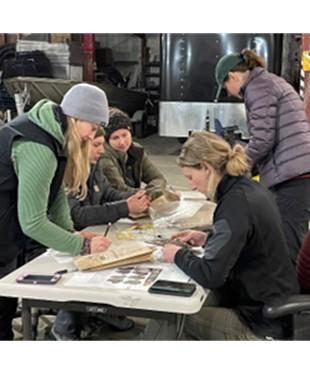
Wildlife Program report: Mar. 1-15, 2023
Managing Wildlife Populations
Chronic Wasting Disease: Wildlife Conflict Specialist Wade fielded Chronic Wasting Disease (CWD) related questions from the United States Forest Service (USFS) range manager. A local newspaper published an article detailing Idaho Fish and Game's response to CWD detection in deer populations near Slate Creek. This article has raised questions among staff and grazing permit holders. Wade recommended that Ungulate Research Scientist DeVivo would be the best source of information. Wade assisted with coordinating between DeVivo and the USFS. DeVivo will be giving a presentation at the USFS’s annual employee orientation in June.
Natural Resource Technician Janowski collected two CWD samples from an elk and a white-tailed deer. The elk was harvested using a landowner kill permit and the white-tailed deer was salvaged from a roadkill.
Forest Grouse: Biologist Lowe, along with staff members from Regions 1, 2, and 3, conducted the annual eastside wing bee in Spokane. Biologists identified species, sex, and age class of forest grouse wings and tails collected from wing barrels during the 2022 hunting season. A reporter from a local news station visited the wing bee. The newscast can be viewed.

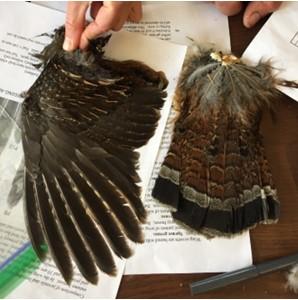
Tyson Foods Permitting: Wildlife Biologist Vekasy responded to a Department of Ecology request for work window recommendations around the artificial wetlands used by the Tyson Foods animal processing facility near Burbank. Water treatment ponds attract both feeding and nesting waterbirds, and we are recommending limited activity and maintenance on the ponds during the breeding season.
Lynx Camera Monitoring: Wildlife Biologists Prince and Turnock replaced a camera in the Kettles for the purpose of monitoring lynx. The cameras are operated cooperatively with Washington State University, Department of Natural Resources, and the Colville National Forest.
Culvert Planning: Sherman Creek Wildlife Area Assistant Manager Daro Palmer hiked in to inspect an unnamed tributary to the Little Spokane River on March 7, where WDFW will be replacing a simple ford with a culvert, for improved water quality and fish passage. He found quite a bit of snow remaining. Palmer scheduled a site visit with Habitat Biologist Bruce Heiner for March 27, as staff members continue to develop plans and determine permitting requirements.
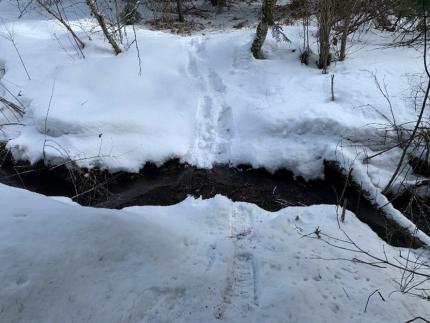
Providing Recreation Opportunities
Tucannon Lakes: Natural Resource Technician Tritt and Natural Resource Worker Jensen continued checking the lakes and fish screens to make sure everything was working properly. Lots of people came to the W.T. Wooten Wildlife Area to fish the Tucannon lakes on the March 1 opener. Wildlife Area Manager Dingman continued working on the Hydraulic Project Approval (HPA) application for the Beaver Lake Inlet to be able to keep water flowing into Beaver and Watson lakes this summer.
W.T. Wooten Wildlife Area Campgrounds: Tritt and Jensen cleaned up trash in the campgrounds. They constructed a buck rail fence along the north edge of Campground 2 to discourage the public from driving into the adjacent field.
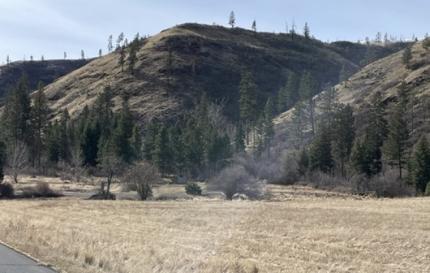
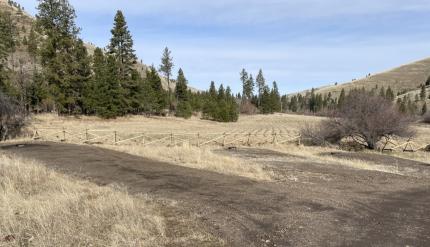
Sherman Creek Road Maintenance: Sherman Creek Wildlife Area Assistant Manager Daro Palmer inspected the winter-closed Bisbee Mountain Road using an ATV on March16, 2023. He found a couple spots where water had ditched the road, but the road was clear otherwise. The ditches will be repaired before the gate swings open for public use on April 1, 2023
Providing Conflict Prevention and Education
Wolf Education Lamont: Wildlife Conflict Specialist McCarty provided guidance and reached out to local ranchers regarding a wolf confirmation in their area that was near a calving pasture.
Pro-Active Deterrents: Wildlife Conflict Specialist Kolb spent part of two days procuring fencing components and installing fladry, turbo fladry, and fox lights on a Columbia County calving pasture. The pasture has experienced wolf activity and depredation by wolves on cattle in the past. Multiple trail camera photos of wolves near the pasture site have been documented over the winter. The pro-active deterrents are an effort by WDFW and the producer to reduce the likelihood of carnivore activity or wolf-livestock interaction.
Asotin County Wolf Activity: Wildlife Conflict Specialist Wade continued to work with producers in the Anatone area regarding wolf activity near active calving operations. Wade met with two producers who had active calving pastures in the immediate area of the recent wolf activity. Wade discussed preventative measures that were currently in place and recommended others. Wade delivered fox lights to one of the producers to deploy around their calving pastures and the other producer deployed fox lights that they had retained from their summer grazing pastures. One of the producers also used temporary fencing to reduce the size of their calving pasture. Wade continued with daily/twice daily updates to producers in the surrounding area and the Asotin County Cattlemen’s Association president. Wade also spent two days checking the area for signs of wolf activity and to attempt to collect information that would help determine how many wolves were possibly in the area. Two wolves were observed near one of the calving pastures and the producer hazed them out of the area with gun fire.
Continuing Education: Natural Resource Technician Harris listened to a webinar on range riding put on by Western Landowners Alliance and Montana State University.
Elk Hazing: Natural Resource Technician Heitstuman traveled to Cloverland to check on commercial crops for elk damage. A large trail was located. Due to the extensive hazing efforts in the area, this herd has become almost completely nocturnal.
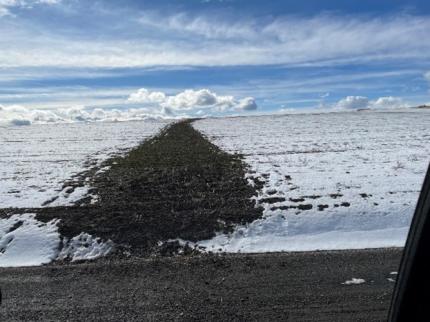
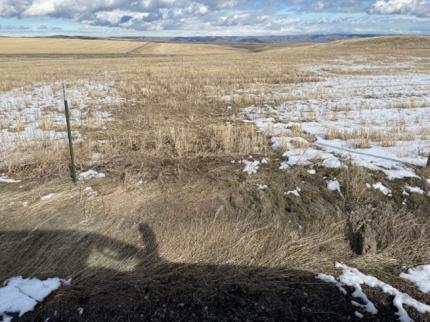
Depredation Investigation, Calf, Davenport: Wildlife Conflict Specialist McCarty assisted in depredation investigation with LEO reported as a wolf but upon arriving landowner was unsure about cause of mortality. Carcass had been removed and the enclosure had been disturbed heavily with human footprints. Coyote tracks were found, blood trail was minimal due to snow melt, but video was provided by landowner that provided insight and confirmed that several coyote track lines were seen, and the blood trail was extensive. Upon skinning calf remains, punctures and scratches on the nose and hocks were indicative of smaller canid species. Confirmed coyote depredation.
Depredation Investigation: Wildlife Conflict Specialist Wade conducted a depredation investigation on a newborn calf that a producer suspected had been killed by a cougar. Wade conducted a necropsy and determined that the calf had likely been stillborn and scavenged by coyotes. Wade assisted the producer with collecting and cleaning up the remaining hide to be used for grafting an abandoned calf to the mother cow.
Reported Wolf Sighting/Depredation: Wildlife Conflict Specialist Kolb and Natural Resource Technician Moberg followed up on a reported wolf sighting and depredation (single chicken) in the town of Dayton. After speaking with the reporting party, Kolb followed up with the Columbia County Sheriff’s Office (CCSO). CCSO reported that one or multiple domestic dogs were reported to have been involved with multiple chicken depredations the previous day. Kolb followed up with the reporting party from the CCSO report, who had photographs of one of the large domestic dogs implicated in the previous chicken depredation. Kolb shared the photo with the reporting party from the most recent incident and the reporting party indicated that it “might” be the same canine. Kolb also spoke with the owner of the chicken that was reportedly taken. The owner of the chicken stated that they were going to repair their fencing so chickens could not get out of their yard. A thorough search of the area reveled domestic dog signs, but no wolf sign.
United States Forest Service Follow Up: Wildlife Conflict Specialist Wade reached out to the United States Forest Service (USFS) range manger to follow up on questions regarding the use of lime for carcass sanitation in the rare case that a carcass couldn’t be removed from the landscape. Wade, Range Manager Druffle and District Ranger Piper discussed the use of lime. Wade answered questions regarding the amount needed. Druffle and Piper requested that Wade inform them if lime is used for carcass sanitation on USFS property and that it is not to be used within the riparian zone. Wade forwarded the information to Conflict Supervisor McCanna.
Asotin County Wolf Activity: Wildlife Conflict Specialist Wade continued to have daily check-ins with the Asotin County Cattleman’s Association president and multiple producers in the area of recent wolf activity. Wade and Natural Resource Technician Heitstuman traveled to the Anatone area to check for signs of wolf activity and to collect information. Wade met with two producers in the area to discuss the recent activity and to deliver more fox lights to one of them. Wade and Heitstuman located tracks from four wolves near where collar data showed there had been recent wolf activity. Wade also received two other wolf reports form Officer Sabo. The first was from a shed hunter who reported seeing three black and three gray wolves traveling near Shumaker Grade. The second was from a homeowner who hazed a black and a white wolf near his home in the Anatone area.

Carcass Sanitation: Natural Resource Technicians Harris and Janowski picked up a horse carcass from a landowner in North Stevens County and transported it to the Stevens County Landfill for disposal. The horse had died of natural causes and the landowner was unable to dispose of the carcass. WDFW staff members assisted to prevent predators from being attracted to the property.
Conserving Natural Landscapes
Shrub Planting: Private Lands Biologist Thorne Hadley planted additional shrubs at a habitat project on a Feel Free to Hunt property in Walla Walla County and removed weed barriers at an old shrub planting site to clean up the area.
Spring Habitat Projects: Private Lands Supervisor Earl met with the Garfield County Conservation District to review and line out the re-plantings that will occur this spring. Earl also visited a site for a potential new project along Deadman Creek in Garfield County.
Chief Joseph Wildlife Area Land Maintenance: Cool weather and light rain did not stop the blackberry vines from burning. Encroaching blackberry vines on food plot agricultural fields were plucked last fall and winter by wildlife area staff and piled for a spring burn. Scientific Technician Meisner and Rimmelspacher also mowed off decadent vegetation of the wildlife area fields to promote new growth and enhance wildlife habitat. Biologist Woodall and Rimmelspacher also planted some native trees and shrubs in a shrub plot that had some openings in the existing planting.
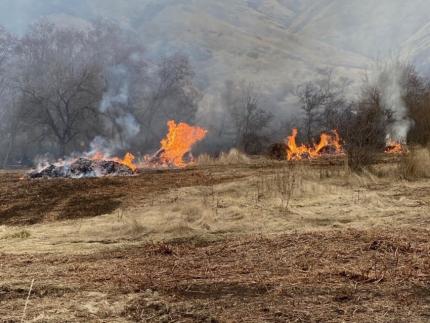
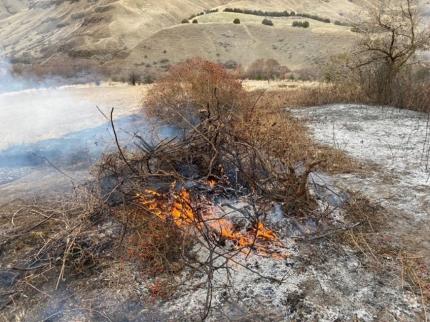
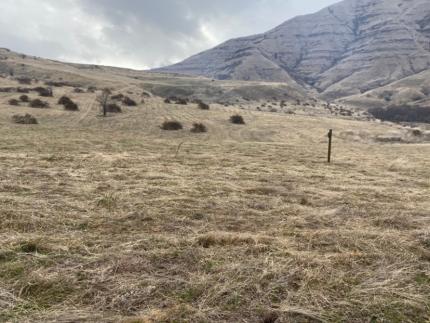
Asotin Creek Wildlife Area Land Maintenance: Wildlife area staff members finally had a good weather window to burn two small fields on the Asotin Creek Wildlife Area. The shooting range and the North Fork Trailhead fields totaling 14 acres burned easily and very fast. This burn will be good for reducing decadent fuels as it ironically did not burn in the 2021 wildfire that consumed everything around it, and the burn will also enhance wildlife habitat.
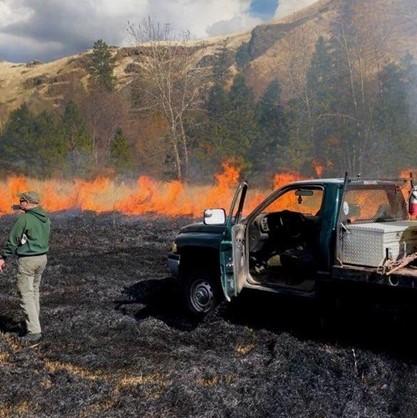
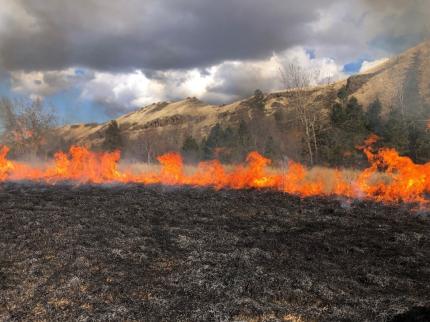
Revere Wildlife Area: Wildlife Area Manager Mike Finch hauled a utility task vehicle to Revere Wildlife Area to meet the Avista Representative Todd McLaughlin to do a visual inspection of the utility line right of way and document the deep ruts caused from the equipment during the repairs after the Wagner Fire last Aug. 18, 2022. According to the easement agreement, the utility company is responsible for any damage caused to the property during the pole replacement. Finch and Avista Representative McLaughlin marked all the damaged areas and will be hiring a contractor to do the repair work. After the repairs are completed, WDFW will broadcast seed those areas back to a native grass mix.
Finch also met Pheasant Forever Mike Gruenke and the new Pheasants Forever President Mike Collier for a site inspection prior to the April 1-2 shrub planting day at Revere for the start of the Wagner Fire habitat recovery. The three took soil samples at two locations at a three-foot depth so the sites can be tested for pH. Over the years several sites have probably failed due to high pH levels and depending on the levels could change the decision on where to plant certain species.
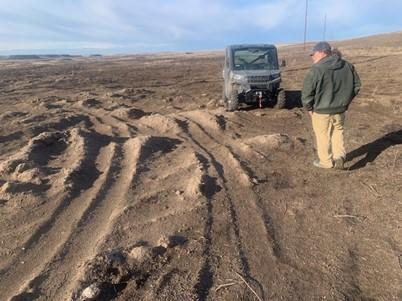

Chief Joseph & Asotin Creek WLA Land Maintenance: David Woodall and Blake Rimmelspacher started their spring spraying. They started with parking lots and buildings, applying a ground sterilant in these sites for fire protection breaks and to keep parking lots vegetation free and looking good. This work will continue into the next week.
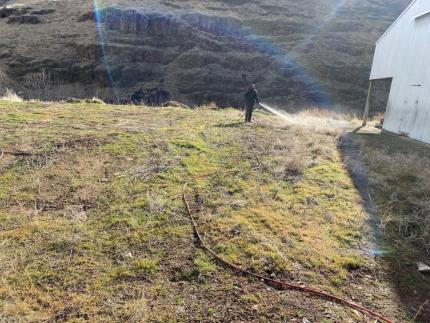
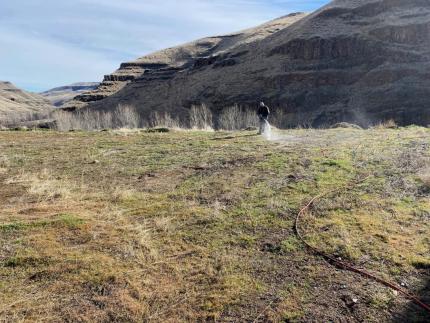
Turkey Habitat Project: Private Lands Biologist Thorne Hadley completed site preparation of mowing and harrowing and then seeded approximately five acres and planted 100 cottonwood trees to complete a WDFW turkey funded habitat project on a Feel Free to Hunt property in Walla Walla County.
Additional Boat-Cleaning Unit: Access Manager Dziekan has been working with Access Section staff members in Olympia to obtain and install free-to-WDFW boat cleaning stations for three access areas: Newman, Badger, and Diamond Lakes. These self-contained, solar-powered stations are produced by CD3 Systems. While not technically decontamination stations, they do allow boat users to clean the outside of their boats before leaving the access area, to slow the spread of aquatic invasive species like quagga and zebra mussels. For an annual software fee, the stations also collect usage data that can be downloaded for analysis by access staff members. Dziekan is scheduled to receive the three units on March 23, 2023. However, on March 13 Dziekan and Wildlife Area Manager Anderson were notified that an additional station would become available, and they were asked if they would be willing to take it. Both agreed to take it, preferably for Williams Lake Access Area, with a backup location of Newman Lake Access Area. The fourth unit will arrive with the other three.
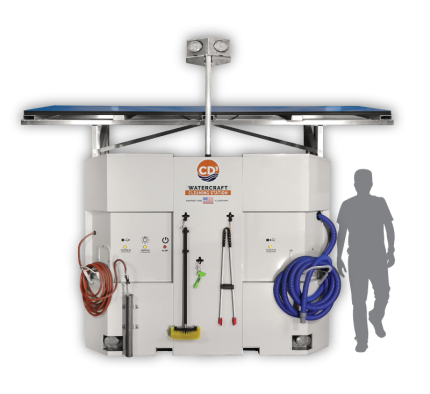
Providing Education and Outreach
Gray Wolf Presentation: Wildlife Conflict Specialist Bennett presented information about gray wolves to an elementary class in Kettle Falls. They provided information of wolf biology, behavior, and answered student questions.
Wilbur/Creston School: Wildlife Area Manager Finch and Private Lands Biologist Baarstad loaded up wood boards in the back of a pickup that were donated by Boise Cascade to WDFW. They hauled them to the Creston School so the shop students could start making blue bird and kestrel boxes prior to the field tour this coming April at Swanson Lakes Wildlife Area. Private Lands Biologist Baarstad will be taking an example of a wood duck box to the Creston School for their shop class to replicate those boxes as well.
Coyotes, South Hill: Wildlife Control Specialist McCarty prepared and edited an existing urban coyote presentation for Rockwood Retirement Community next week.
Volunteer Project: Biologist Baarstad worked with Hunter Education and Volunteer Coordinator Dazey to request volunteers to build more wood duck nesting boxes. Several master hunters responded, willing to help. The boxes will be placed in various locations on private lands and wildlife areas throughout eastern Washington.
Bighorn Show: Wildlife Biologist Prince and Wolf Biologist Roussin gave a presentation entitled “Managing Large Carnivores” at the Bighorn Show in Spokane. Unfortunately, attendance at the presentation was very light. However, those that did participate were given a free can of bear spray.
Bighorn Outdoor Adventure Show in Spokane: Region 1 Access Manager Dziekan helped set up the WDFW booth at the annual Bighorn Show. He worked a Saturday shift as well. Wildlife Area Manager Juli Anderson worked a Friday shift.

Creston Junior High School Science Grant Project: Wildlife Area Manager Finch is working with Creston Junior High School teacher Rosman, Creston Shop Teacher Clark, Conservation Education Curriculum Developer Eckenrod and District 2 Habitat Biologist Mackelvie planning for a student science grant project that the Creston School was successful in acquiring early this year. The project will take place one day in April and another day in June at the Swanson Lakes Wildlife Area with students collecting habitat data and identifying plants to try to identify a trend since the Whitney Fire. Eckenrod contacted Finch to discuss different educational outdoor science opportunities prior to the pre-field trip tour with just teachers on April 6.
Conducting Business Operations and Policy
Administrative Duties: Wildlife Area Manager Anderson met Swanson Lakes Wildlife Area Manager Mike Finch at Swanson Lakes headquarters on Thursday, March 2, to bring Finch up to speed on Bonneville Power Administration’s (BPA’s) CBFish online contracting system for Fish and Wildlife contractors. BPA completely funds Swanson Lakes Wildlife Area, and Finch has assumed the duty of developing and managing the annual contracts, on the WDFW side. Lands Division Fiscal Analyst Nelson also had a video call with Finch and Anderson mid-day, to discuss some expenditure issues. It was a very long but productive day.
New Damage Permit System Call: Wildlife Conflict Specialist Wade took part in a committee meeting for the new damage permit system. The committee decided to scrap the program that they were testing and seek a program created and managed by an outside vendor.
Collaboration Efforts with the Natural Resources Conservation Service: WDFW Private Lands staff members and Farm Bill Coordinator Reseland discussed an upcoming new agreement between the Natural Resource Conservation Service (NRCS) and WDFW. Collaborative work between the agencies has been strained in the past due to workload and timeline issues, so Farm Bill Coordinator Reseland will meet with the NRCS to discuss new agreements going forward.
Ducks Unlimited North American Wetlands Conservation Act Grant: Private Lands Biologist Gaston received notice from local Ducks Unlimited Biologist Blewett that they were successful in obtaining their North American Wetlands Conservation Act (NAWCA) grant. Private Lands Biologist Gaston worked with the Ducks Unlimited staff members to provide habitat restoration information on work already completed and assist their grant application. The grant received is for $100,000 and focuses on wetland restoration on Revere Wildlife Area in NW Whitman County. Additionally, it includes work being done by Private Lands Biologist Gaston as part of his private land's waterfowl habitat restoration program as well as work done by Swanson Lakes and Revere Wildlife Area Manager Finch.
Asotin Creek Wildlife Area Fence Work Update: A third contractor has been hired by Capital Asset Management Program (CAMP) to work on the Smoothing Iron segment of fence. The CAMP project manager and the contractor with his crew are arriving on Monday to begin work. Dice looked at fence lines at Smoothing Iron and found some of the lines are still snowed in. Deadfall trees were blocking some of the trails and Meisner and Dice sawed out the trails in Cooper Canyon and South Fork on Wednesday. Surveyors from Pace Engineering arrived this week and began their work to complete marking WDFW property lines at Harlow Ridge and in South Fork.
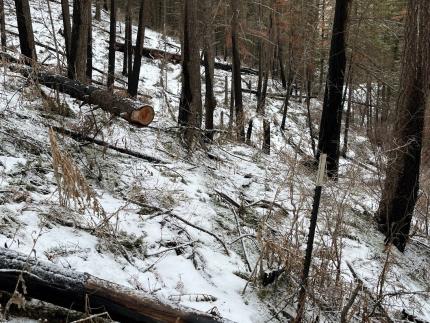
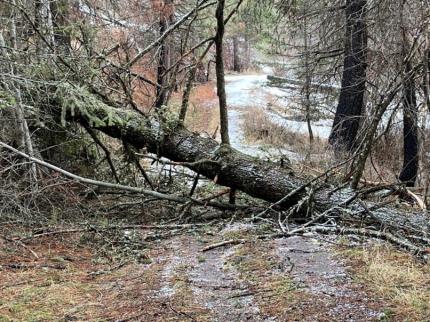
Fish and Wildlife Commission Blue Sheet Presentation: Wildlife Conflict Supervisor McCanna traveled to Wenatchee and was part of a WDFW team that responded to a blue sheet request from WDFW Commission. McCanna presented on how WDFW works with the Department of Agriculture on their grants, range rider coordination with grant recipients, and non-lethal tools used to mitigate wolf-livestock interactions and depredations.
Other
Whitman County Joint Conservation Districts Annual Meeting: Private Lands Biologist Gaston attended the joint Conservation District Annual Meeting in Colfax. Information about pesticides and habitat in Whitman County was distributed.
Stevens County Conservation District Meeting: Natural Resource Technician Janowski, Natural Resource Technician Harris, and Biologist Baarstad attended a meeting between WDFW and the Stevens County Conservation District. The meeting produced several collaborative project ideas between both organizations.
Managing Wildlife Populations
Washington Ground Squirrels: Biologists Dougherty and Clements visited a couple of sites earlier this month in regards to potential ground squirrel translocations. Biologist Dougherty confirmed that ground squirrels are present, and they are expecting to begin the translocation process in early March.
Northern Leopard Frogs: Biologists Clements, Dougherty, and Grabowsky all participated in interviews to hire a technician to assist with leopard frog field work this spring. There were nine candidates interviewed for the position, and the hope is that the successful candidate will be able to begin working in mid-March or early-April.
Waterfowl: Biologist Clements worked with the Moses Lake Washington Conservation Corps (WCC) crew to construct a new floating duck trap to use in the 2023 waterfowl banding efforts. Their efforts were very successful, and the trap will be deployed later this year.
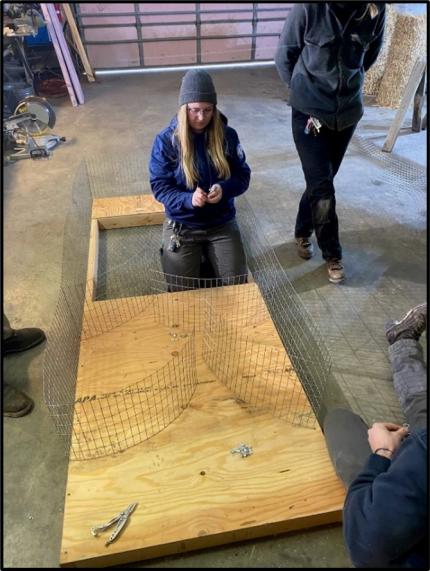
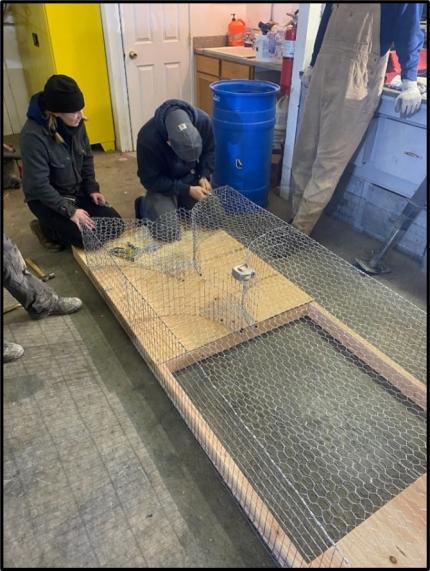
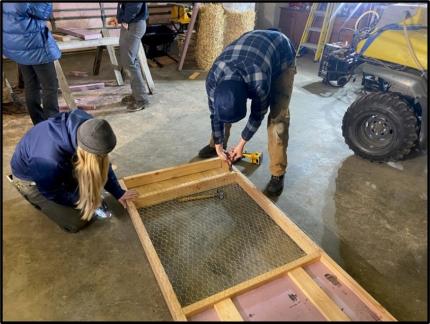
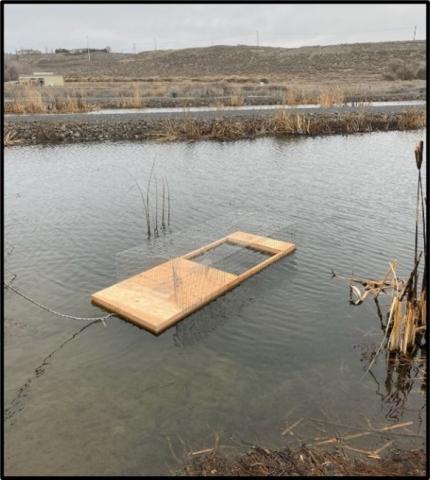
Greater Sage-Grouse and Sharp-Tailed Grouse: Biologist Eilers mailed out letters to 101 private landowners in Douglas County asking for land access permission to survey grouse on private property. Starting in late March 2023, biologists will be searching for new greater sage-grouse and sharp-tailed grouse leks and monitoring known leks across Douglas County to get population estimates of these species. Douglas County currently has the greatest abundance of greater sage-grouse in the state of Washington. However, populations are declining.
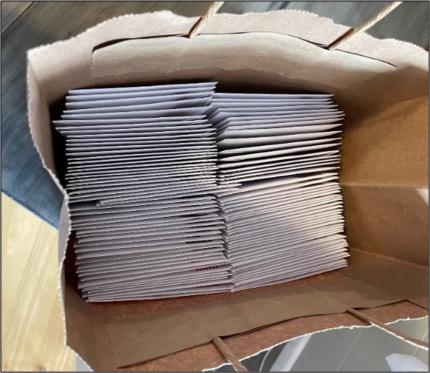
Forest Grouse: Biologist Eilers traveled to Spokane to join other WDFW biologists from the eastern half of the state in identifying wings and tails collected in wing barrels throughout the forest grouse season. Grouse hunters are asked to collect wing and tail samples from each bird they harvest, place these samples in a special paper bag, and then deposit them at one of the wing barrels located across the state.
At the end of the season, biologists meet up to examine the wings and tails and identify species, sex, and age of the harvested birds. This data helps scientists track species’ ranges and monitor the health of the grouse population statewide. Biologists can then use this information to adjust management actions such as our harvest regulations to ensure the perpetuation of sustainable forest grouse populations.
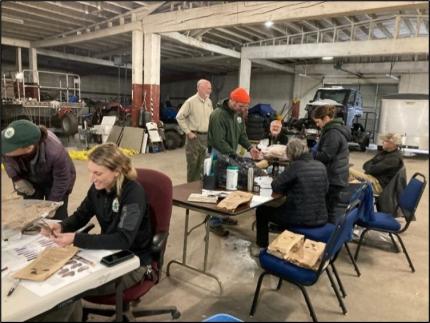
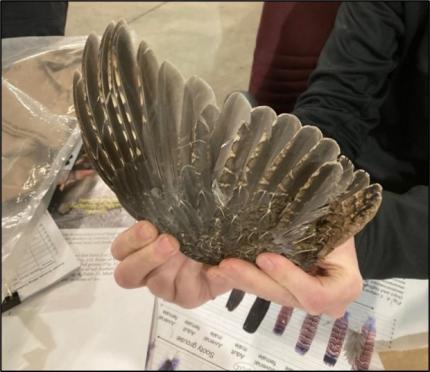
Pygmy Rabbit Wild Trapping: Wild captures continued in the Sagebrush Flats Wildlife Area. In total, 12 pygmy rabbits were captured and 11 were vaccinated against Rabbit Hemorrhagic Disease Virus Serotype 2 (RHDV2). These trapping efforts are a cooperation of many different agencies and partners. In the past two weeks, representatives from the Bureau of Reclamation, Bureau of Land Management, Pheasants Forever, WDFW staff, and WDFW volunteers have arrived from around the state to help protect the Columbian Basin pygmy rabbit. The most exciting capture was Pygmy Rabbit BHE014. This rabbit was born in the Beezley Hills enclosure and then released in the Palisades area. Much to everyone’s surprise, this female rabbit travelled to the Sagebrush Flats Wildlife Area—approximately six miles. For a small 444-gram rabbit that is quite the distance. This information has completely shattered our concept of how far these rabbits can move on the landscape.

Whenever we intervene with wildlife, a great risk is assumed. Every time a trap effort occurs the team does everything to mitigate these risks. Personnel receive proper training and rabbits are handled as little as possible. Despite these precautions, one of our pygmy rabbits suffered from capture myopathy. Capture myopathy is a stress-induced condition that results in fatality. The carcass was sent to the Washington Animal Disease Diagnostics Laboratory for a necropsy. It was determined that the pygmy rabbit was already in poor health and the stress of trapping likely caused its demise. Each loss is heart-breaking, but we recognize that our overall vaccination efforts will benefit the species as a whole.
Coccidia Monitoring: Coccidia monitoring season has begun. Biologists Soltysiak and Technician Meacham collected fecal samples from each breeding enclosure. These samples will then be inspected under a microscope for the presence of coccidia eggs. Coccidia is a parasite that lives within a rabbit’s intestines. The eggs of this parasite are shed through its fecal matter. Young rabbits are particularly susceptible to coccidiosis. Coccidia is often only a problem in areas where rabbits are in close contact with each other. If we find that coccidia levels are high in an area, the rabbits are then treated with an oral medication.
Search Efforts: With the new knowledge of how far pygmy rabbits can travel, search efforts have been re-vamped. Biologist Soltysiak and Technician Meacham have been looking through thick sagebrush stands in the Rimrock and Palisades areas. Thus far no new populations have been found but the team remains optimistic for this possibility.
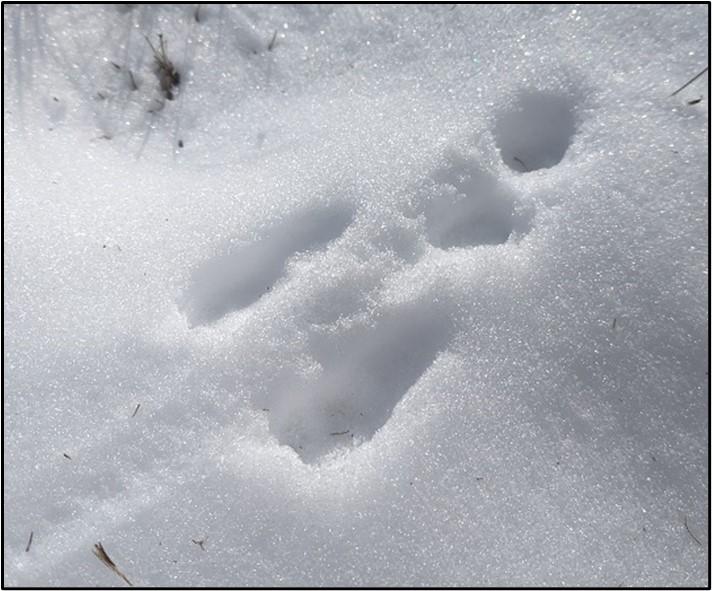
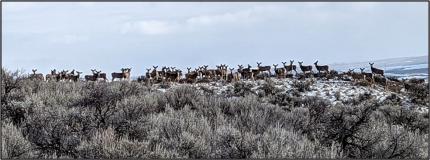
Mule deer: Biologists Jeffreys and Eilers responded to two mortalities from GPS-collared mule deer in the Wenatchee mountains. Biologists performed mortality investigations at each site and determined that the first mortality was predation via cougar and the second mortality was predation via coyotes.
Both of these does were originally collared as adults back in January 2020 as part of an ungulate movement and migration study being conducted in several Washington herds as well as across the western United States. Biologists have used location data gleaned from these GPS collars to learn valuable information about timing and duration of migration, migratory corridors and stopover points, and winter and summer range used for mule deer wintering in the Wenatchee Foothills and the Burch Mountain and Swakane areas.
Between 2020 and 2022, approximately 68 does were collared in Chelan County. In addition to mortalities taking place over the past few years, a few collars have failed (stopped transmitting due to battery failure or other unknown reason). Currently, slightly over half of the original sample are still known to be alive and transmitting GPS signals (around 36).
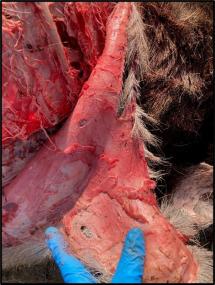
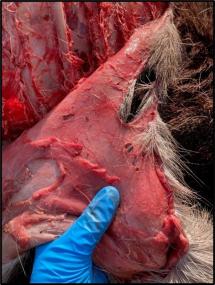
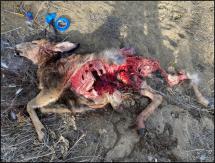
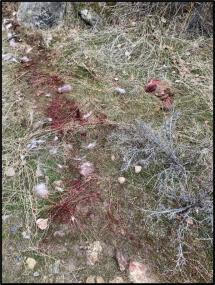
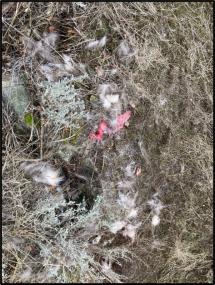
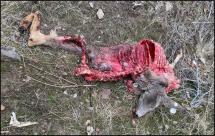
Safe Harbor Agreements: Biologist Morris met with several landowners to sign and finalize Safe Harbor Agreements and discuss any final questions. These two Safe Harbor Agreements will now be sent to the U.S. Fish and Wildlife Service for approval and permitting, which will provide regulatory assurances to the landowners so they can continue their regular farming operations on over 8,000 acres while ensuring that pygmy rabbits and their habitat are preserved at the same time.
Lynx Research: Biologist Fitkin partnered with the Home Range Wildlife Research Crew on the immobilization and radio-collaring of the project’s first study animal, Riker, a 22.5-pound adult male estimated to be about three years old. Early data collection suggests the cat’s territory is centered within a portion of the 2006 Tripod Burn area. The primary objective of this multi-year project is to see how lynx are using the fire-impacted landscape across a gradient of fire scars of different ages. Results will inform forest and fire management strategies to help maintain adequate lynx habitat in the face of growing wildlife risk. More information on this project and the locally grown Home Range Organization can be found on the Home Range website. Also of note, the crew recently captured a fisher in one of the lynx traps less than three miles from where one was picked up on a wolverine survey camera last summer. This suggests there may be a resident fisher in the study area.
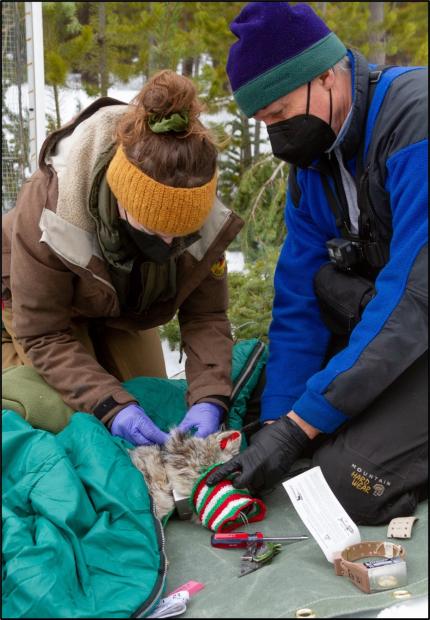
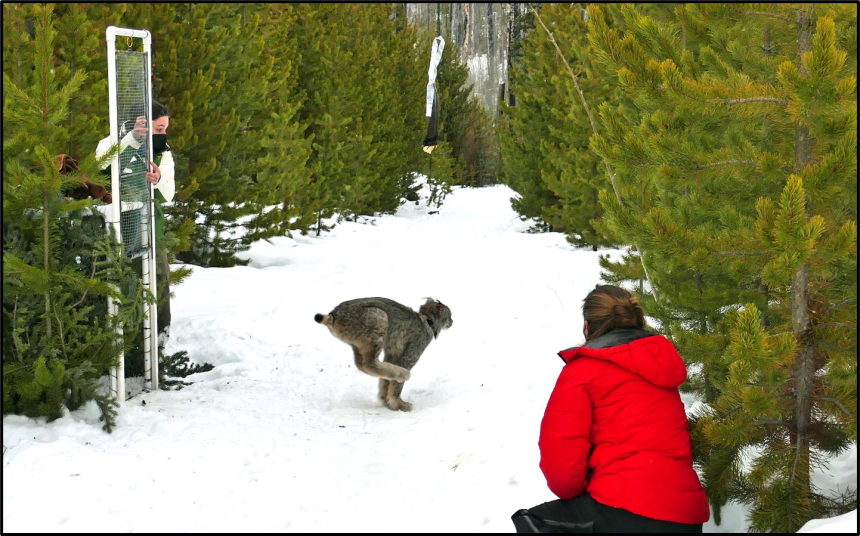
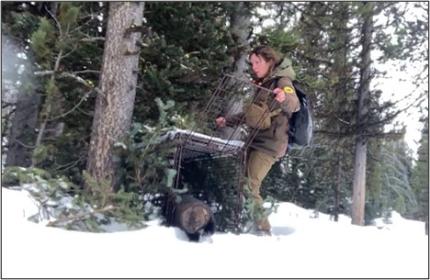
Providing Recreation Opportunities
Regulated Access Area Harvest Data: Specialist Walker finished inputting data collected from regulated access area hunter registration cards. Hunter registration cards provide beneficial information for wildlife area staff members to aid in the knowledge of public usage and productivity of each regulated access area.
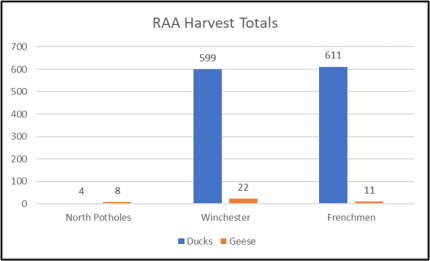
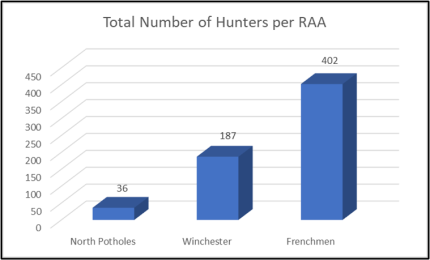
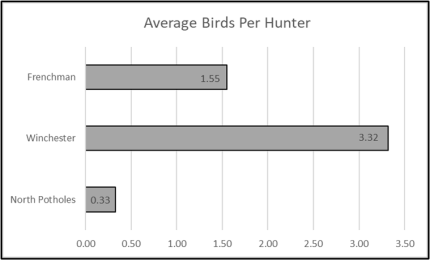
Water Access: Steele has now completed the construction of a new foot bridge for the Fish Trap access site at Lake Lenore. Water access staff members will soon install the bridge making it accessible to the public. The bridge was prefabricated in the shop.
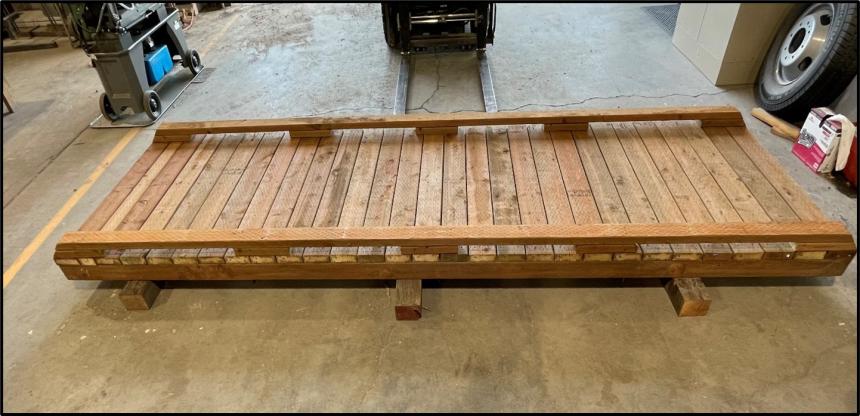
Hunter Access Program: Biologist Morris updated hunter access maps and replaced damaged and vandalized signs on hunter access properties. Morris contacted all the landowners enrolled in Hunt by Written Permission to request they return their written permission slip stubs. These stubs allow the department to track how much public access is being provided through this program.
Quincy Lakes Trails: Lands Operations Manager Finger, Wildlife Area Manager Eidson, Recreation Planners Anderson and Browning, and TREAD Executive Director Lyons checked 18 miles of trail to discuss a sustainability assessment contract between WDFW and TREAD to help us maintain and improve our trails system.
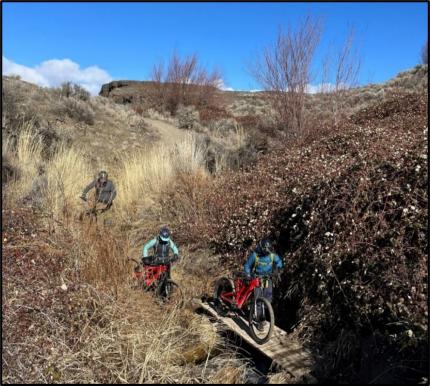
Providing Conflict Prevention and Education
Depredation Hunts: Specialist Bridges continues to respond to numerous landowner concerns of deer and elk depredating on agricultural crops. This year has been exceptionally busier than the previous 10 years. Depredation response has included: Information and education, on site visits, distributing non-lethal materials, Damage Prevention Cooperative Agreements and Permits.
Interagency Relationship Building: Specialist Bridges went on a ride-a-long with Chelan County Commissioner Tiffany Gering to discuss bear issues along the south shore of Lake Chelan. This was a great opportunity to meet, explain the issue, and develop a relationship with the commissioner. Most of the discussions centered around wildlife biology and how wildlife utilizes human environments, and how that contributes to human and wildlife conflicts. We also discussed the realities of what can be done once a bear conflict starts, and the reasons behind the saying “a fed bear, is a dead bear.”
No Shooting Signage: Biologist McPherson coordinated with Signs by Terri to make an order of agency approved, no shooting signs. Signage will explain new target shooting regulations and will be available in English and Spanish.

Cost-share Fencing Agreements: Specialist Heilhecker wrote three draft cost-share fencing agreements. Two agreements will protect orchards from deer in Game Management Unit (GMU) 209. The third agreement will protect haystacks from elk in GMU 204. She sent the drafts to each landowner for their consensus on the boundary map for the fence and list of fencing materials. She also called the fencing supply company to get a cost estimate for the fencing materials.
Elk in Haystacks: Specialist Heilhecker received a complaint of elk damaging haystacks in GMU 204. Previous efforts to reduce conflict has proven to not be effective. Specifically, non-lethal deterrence measures, including hazing and temporary fencing, were employed to reduce and eliminate the elk in the haystacks. After all other efforts failed, Heilhecker issued the landowner a kill permit to remove one antlerless elk at the haystack.
Responding to Wolf Reports: Specialist Heilhecker entered an unconfirmed wolf sightings report to Spillman. The reporting party stated the animal was multi-colored brown and about the same size as a German Shepherd only skinnier and “leggy”. The sighting was located within the Beaver Creek territory. The reporting party likely saw a wolf, but it is hard to confirm sightings reports without photos of the animal or tracks.
Conserving Natural Landscapes
State Acres for Wildlife Enhancement – Conservation Reserve Program: This week Private Lands Biologist Braaten informed Douglas County Natural Resource Conservation Service (NRCS) that NRCS funding for WDFW to assist with SAFE-CRP has been spent and work is now on hold. Private Lands Biologist Braaten has been working with private lands and regional staff to work through issues that have come up regarding Farm Planner Certifications.
Braaten confirmed that last year’s State Acres for Wildlife Enhancement 14 contracts were never signed and have been deemed invalid. This was very disappointing to hear because of all the field and office work that went into developing the plans, over the span of two months, took time away from other WDFW tasks. Braaten requested that WDFW ensure that NRCS provides assurances going forward that this will not happen again.
TD-4 Russian Olive Removal: TD-4 project has wetlands that are ringed by Russian olives and phragmites. Biologist McPherson coordinated with WCC to remove Russian olives around wetlands so wildlife area staff members can gain access to treat tall emergent vegetation. The crew completed the southern portion of the wetlands and has a few areas yet to complete. Then materials can be burned and tall emergents can be treated.
Winchester Russian Olive Removal Area: Wildlife area staff members have been working on burning piles of Russian olive around the Winchester wasteway. Piles have been aging for two years to help consumption of materials. Focus has been primarily on the east side due to conditions and the westside will need some preparation work before burning can commence.
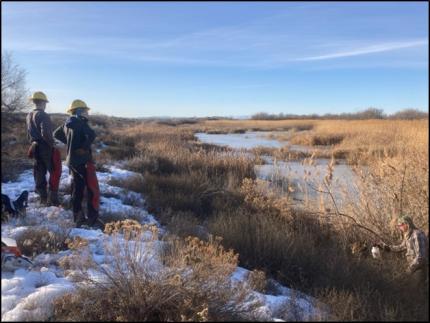
Bonneville Power Administration Transmission Line Maintenance: Bonneville Power Administration (BPA) anticipates doing maintenance on structures, easement roads, and under lines at Quincy Lakes, Winchester Wasteway, and Rocky Ford. Biologist McPherson met BPA Natural Resource Specialist Rieman at all three locations to go over potential work and any concerns the wildlife area would have. All scheduled work will not have any major impact on habitat or public recreation.
Providing Education and Outreach
Methow Conservancy Presentation: Local high school Science Teacher Fitkin and her dad, Biologist Fitkin, presented a talk for the Methow Conservancy’s First Tuesday Lecture Series on the recovery of and coexistence with biodiversity in the North Cascades. The presentation touched on the recovery of many taxa with an emphasis on rare carnivores. It also highlighted the important wildlife habitat values of the Methow Conservancy’s current project to permanently protect the 1200-acre Sunny M Ranch near the town of Winthrop.
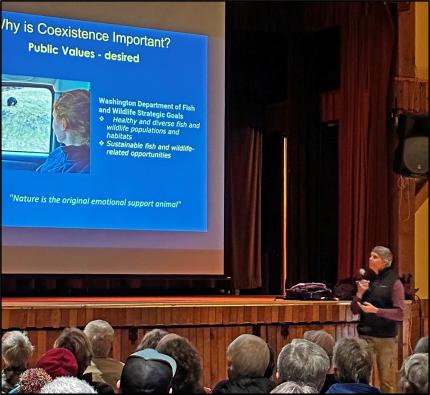
Grant Elementary School Science Fair: Biologist Cook with help from Biologist Soltysiak, Technician Meacham and Administrative Assistant Jones participated at the Grant Elementary School Science Fair in Ephrata and helped children and families learn about wildlife. Soltysiak and Meacham assisted attendees in exploring details of skulls, foot and footprint molds, and pelts of several mammal species. They explained reasons for specialized teeth, skull, and foot features that help species be adapted for survival. Jones supplied coloring pages and books and paper masks featuring beneficial insects and aided children with supplies. Cook helped with the skulls, pelts, and molds when needed and helped children “make their own creature” with adaptations for survival.
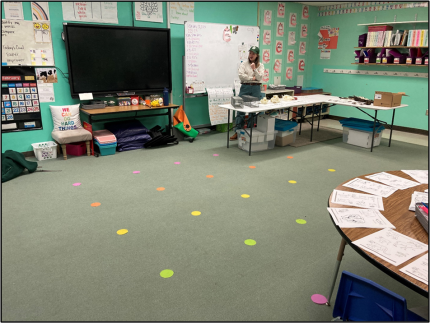
Conducting Business Operations and Policy
Road Maintenance at the Frenchman Regulated Access Area: Specialist Walker used the rock rake to complete road maintenance at the Frenchman Regulated Access Area. This road is used by wildlife area staff members to access the project and is used by ADA hunters who register to hunt at one of the two designated ADA duck blinds.
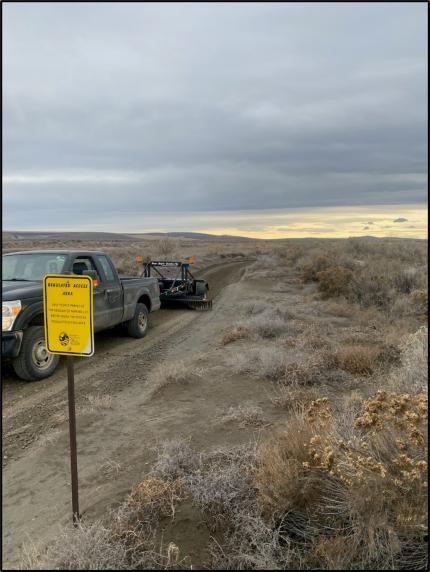
Other
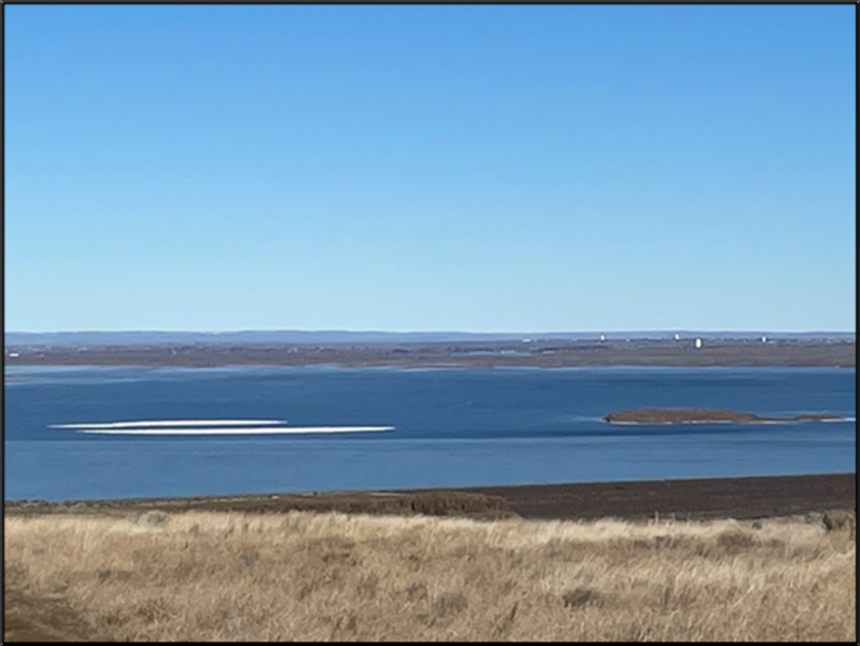
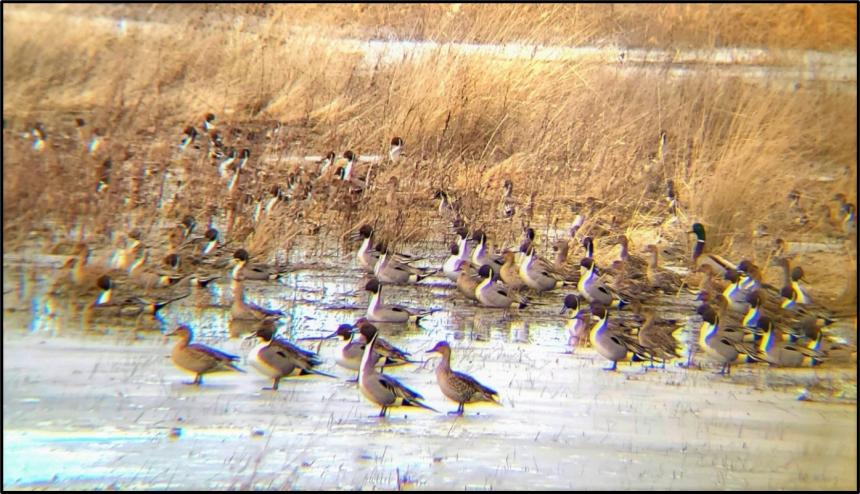
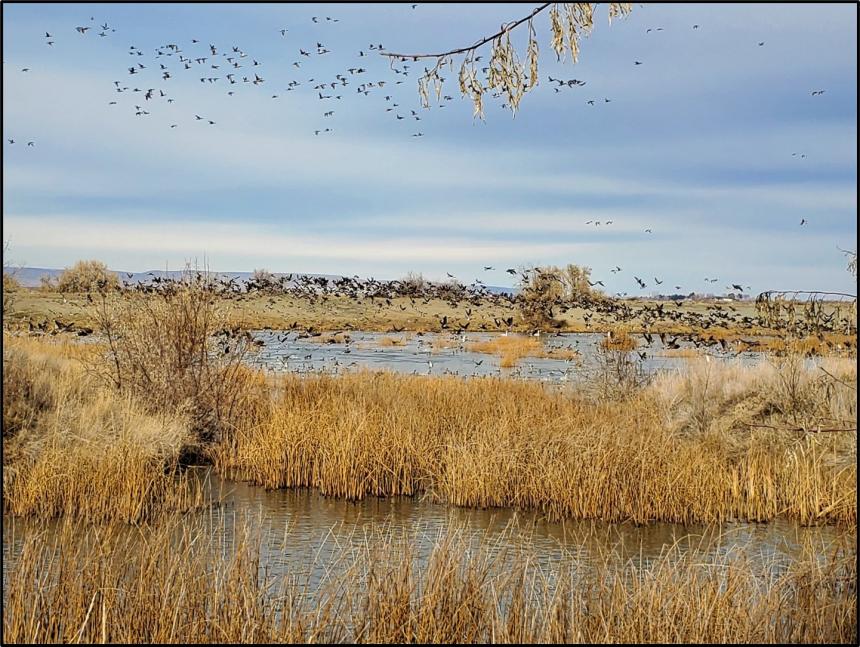
Managing Wildlife Populations
California Sight of a Burrowing Owl from Washington: A male burrowing owl banded in June 2022 on the Rattlesnake Unit of the Hanford National Monument as part of a demographic study was found wintering near McKinleyville, California last month. A photographer got several photos of the banded owl to identify its origin. This owl’s coastal northern California wintering grounds is 700 kilometers away and a very different habitat than the shrubsteppe and grassland of its breeding site here in Washington. Resights of banded owls from Washington are infrequent so this sighting provides important data in understanding the wintering grounds and migration of our Washington breeding burrowing owl population.
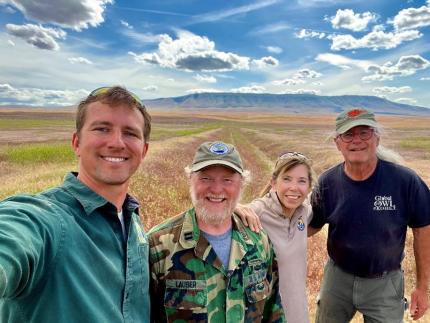
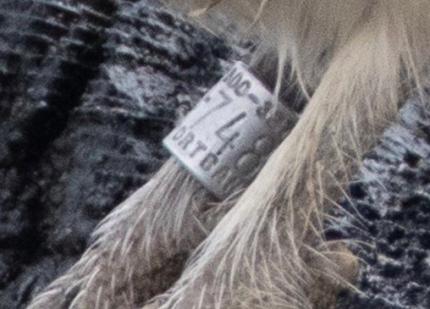
Artificial Burrows for Owls Ready for Spring: Wildlife Biologist Fidorra and volunteers worked to prepare and repair 65 artificial burrows for burrowing owls on lands surrounding the Tri-Cities.
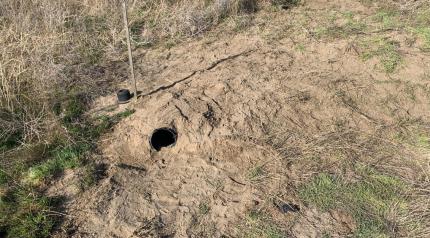
Cackling and Snow Goose Tagging in Columbia Basin: District 4 Wildlife Biologist Fidorra assisted Waterfowl Specialist Wilson along with additional agency staff and Alaska Fish and Game biologists to capture and tag cackling geese and snow geese for migration studies. California Fish and Wildlife contributed the snow geese tags. Four tags were placed on Taverner’s geese and 17 on snow geese at McNary.
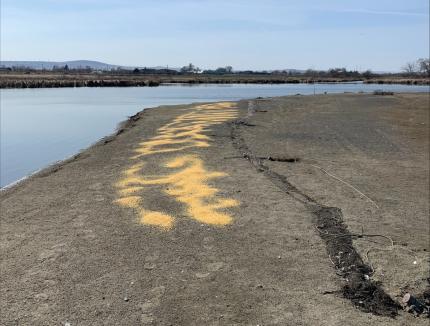
Colockum Elk Surveys: Colockum Wildlife Area Manager Lopushinsky assisted Wildlife Program staff members Moore and Wampole in conducting the annual aerial elk surveys on the Colockum. Staff members used a parking lot at the top of the Wild Horse Wind Farm to launch and refuel the survey helicopter. Colockum Manager Lopushinsky appreciated Assistant District Biologist Wampole choosing a beautiful day to fly and survey elk.
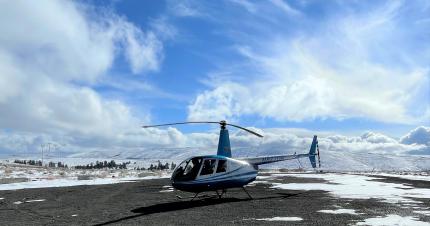
Goose Capture: Biologists Bernatowicz and Wampole assisted Waterfowl Specialist Wilson and biologist from Alaska capture cackling geese as part of an ongoing cooperative study. After a day and a half of watching geese land and walk everywhere but in front of the net, 53 geese were captured. Unfortunately, the majority, 49, were small cacklers and not the wanted Taverner's cackling geese. Four transmitters were deployed on the four Taverner's. It was obvious that the geese were somehow aware of the nets and actively avoiding them. The fields were cattle pastures where lines of hay are common. The rancher even believed the geese were present due to left over alfalfa hay.
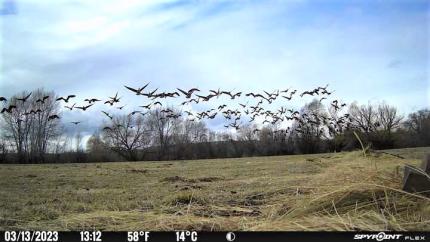

Coordination Meeting with the Yakama Nation Wildlife Program: Region 3 Wildlife Program staff attended a meeting with their counterparts at the Yakima Nation. The purpose of the meeting was meant to discuss shared priorities and management objectives including pronghorn, big horn sheep, mountain goat and waterfowl.
Cougar Harvest: District 8 Biologist Bernatowicz sealed a cougar harvested by a tribal member on the Yakama Reservation. The hunter had a lot of questions about cougars and bears, which he believed were numerous on the reservation. The SURVEY123 system did not appear to be set up for tribal harvest as it required Game Management Unit (GMU) and WILD ID.
Elk numbers have been high at the Watt feed site as weather and temperatures fluctuate between sun, snow, rain, and wind and 22 to 42 degrees Fahrenheit. Numbers have been low at the Robinson site with estimates ranging from 1 to 300 and feeding has been based on hay left over from the last feeding, occurring every other day on average. Bulls are just beginning to lose their antlers and feeding is anticipated to end as grass begins to green up with warmer night temperatures.
DATE | SITE | COW/CALF | BRANCHED BULL | SPIKE BULL | Mortality | TOTAL |
|---|---|---|---|---|---|---|
2/11/23 | Watt | 592 | 48 | 16 |
| 656 |
2/11/23
| Robinson | 529 | 47 | 16 |
| 592 |
2/17/23 | Watt | 143 | 19 | 12 | 0 | 174 |
2/27/23 | Watt | 735 | 19 | 31 | 1 | 785 |
2/28/23 | Robinson |
|
|
|
| 350 (estimate) |
3/6/23 | Watt | 693 | 32 | 30 |
| 755 |
3/13/23 | Watt | 625 | 7 | 20 |
| 652 |
Burrowing Owl Data Submitted to WDFW database: District 4 Wildlife Biologist Fidorra compiled and submitted eight years of study data from the Tri-Cities Burrowing Owl Project. This data is important to enter as it feeds the Priority Habitats and Species database which is used in land developers during project siting.
Providing Recreation Opportunities
Wenas Target Shooting Clean Up: Recreation Specialist Frame removed 520 pounds of trash from Sheep Company Road target shooting area and Sheep Company Road and Cottonwood Creek Area. Small campfires composed of trash are common in this area.
Cleaning up Private Lands Hunting Opportunity: Private Lands Biologist Hulett and Private Lands Technician Manderbach cleaned up a private lands access site that has been plagued with litter. In total 9,500 pounds of litter was collected and taken to the transfer station.
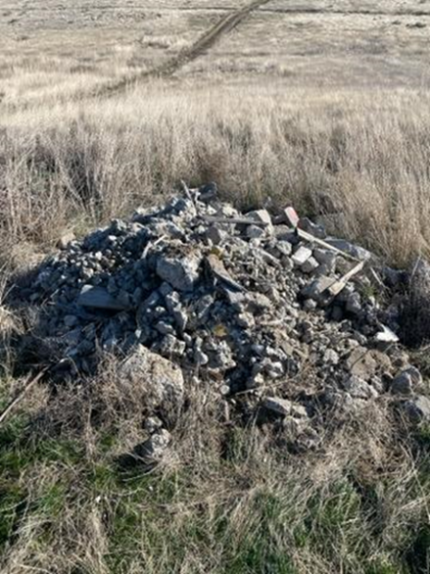
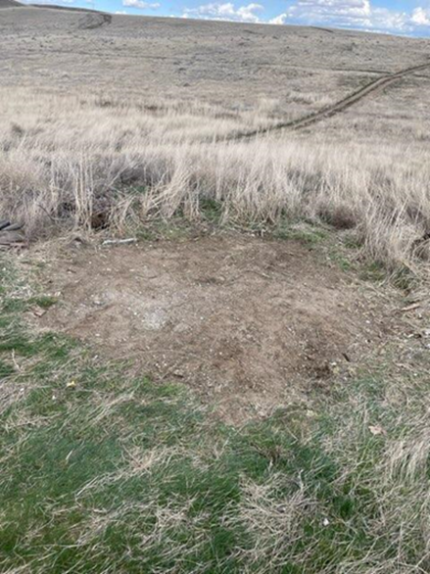
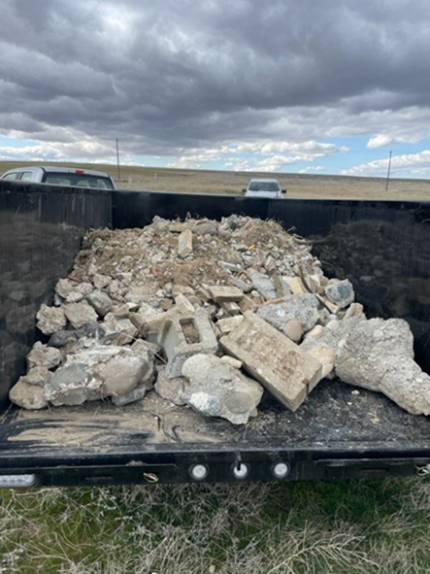
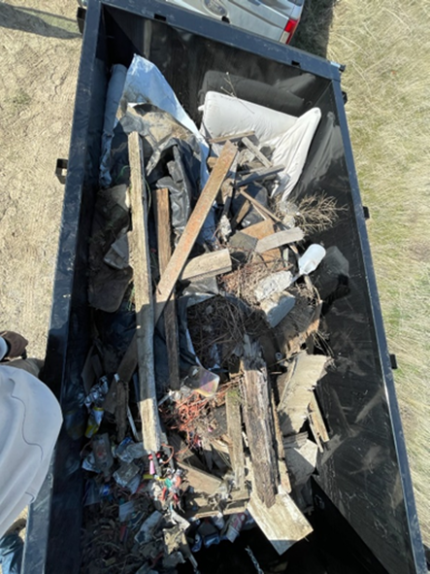
Grading Parking Lots: Natural Resource Tech Barbosa has started to grade smaller public access area in the Lower Valley.
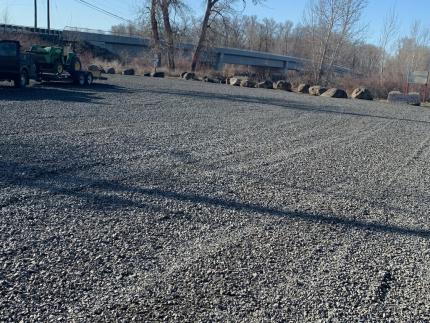
Dumping: Natural Resource Tech Barbosa and Access Manager Garcia removed a large dump pile at Duportail public access. Officer Fulton discovered the trash while patrolling the area and informed Manager Garcia of the findings.
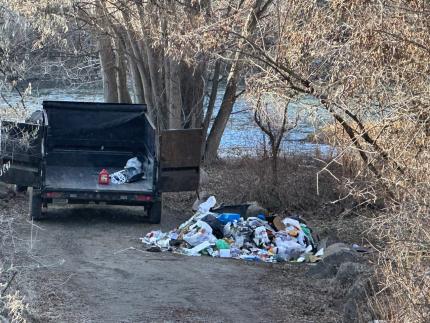
Hazardous Tree: Access Manager Garcia removed a hazardous tree that was along the entrance to Teanaway Junction.
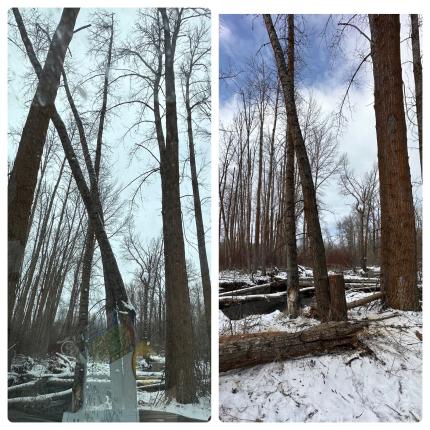
Graffiti: Natural Resource Tech Barbosa painted out graffiti at Pond 6, unfortunately the site was tagged again the next day.
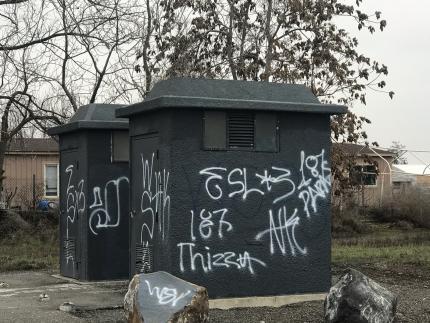
There has been a lot of waterfowl activity at the Sunnyside Headquarters Unit. Snow geese, white-fronted geese, and swans have been foraging in the agriculture fields near headquarters.
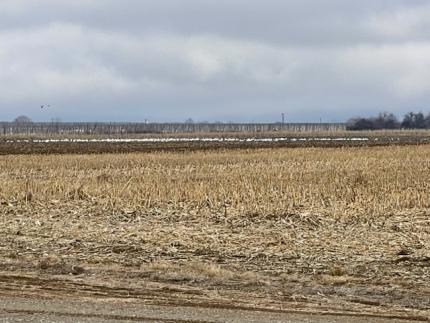
Providing Conflict Prevention and Education
Rattlesnake Hills Elk: Wildlife Conflict Specialist Hand had contact with landowners on Rattlesnake Mountain concerning current weather conditions and access. Heavy amounts of drifting snow and cold temperatures at the end of February had some roads in the area closed. Elk are continuing to utilize low elevations areas near highway 240 on the Hanford National Monument.
Ringold Beaver Damage: Wildlife Conflict Specialist Hand met with an orchard owner in the Ringold area along the Columbia River that had sustained damage to several of his cherry trees from beavers. Multiple preventative strategies were discussed as well as contact information provided for hiring a licensed nuisance control operator.
New Damage Permit System: Wildlife Conflict Specialist Hand participated on the new damage permit testing team. The first iteration of the permit system had numerous functionality issues and has been scrapped. WDFW Information Technology Division will be working with an outside vendor to start development of a new damage permit development platform with hopes of having a workable solution by early fall 2023.
Kahlotus and Paterson Deer: Wildlife Conflict Specialist Hand continued to conduct deer hazing operations at multiple winter wheat fields in the GMU 381 and wine grape vineyards near Paterson. Current mild weather conditions have deer finding adequate forage in non-crop areas.
Conserving Natural Landscapes
Byron Unit: Assistant Manager Ferguson and Natural Resource Technician Wascisin continued beaver-proofing the culvert underneath an access road in the Byron Unit with additional cattle panels after retaliatory efforts from the resident beavers causing blockages. The panels are keeping the beavers away from the culvert now, but new dams have been created upstream and downstream of the road crossing.
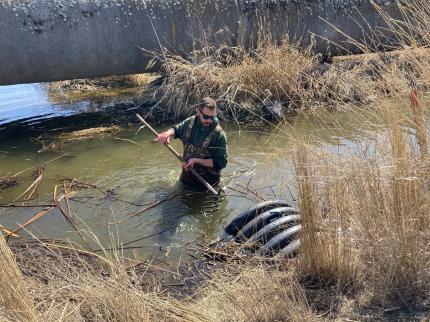
Sunnyside Wood Duck Boxes: Natural Resource Technician Wascisin helped Richland Rod and Gun Club volunteers with yearly cleaning and repair of wood duck nest boxes at the Sunnyside and Byron units.
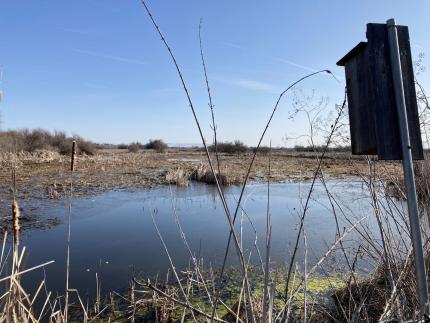
Sagebrush Planting: Habitat Specialist Miller and Recreation Specialist Frame began planting Sagebrush in the Wenas Wildlife Area. These plantings will help to supplement natural regeneration of sagebrush within the Wenas Wildlife Area. Sagebrush plugs will be planted throughout the Cow Canyon Fire, Cleman Mountain, and sites that burned in the Evans Canyon Fire.
Shrub-Steppe Restoration: Colockum Wildlife Area personnel used the Colockum landing craft to assist in hauling restoration equipment and supplies to an area burned by the 2022 Whiskey-Dick Wildfire. WDFW staff members used the boat to transport an all-terrain vehicle, seeder, harrow and native grass seed to be used for early spring seeding. Access roads to the area are still snowed in making vehicle access difficult.
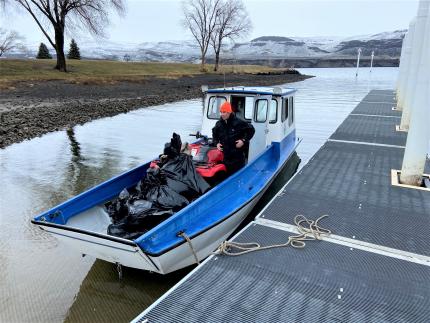
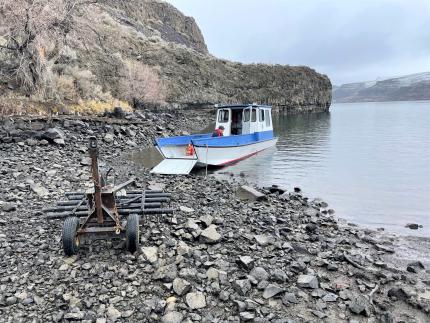
Colockum Forest Restoration: Work has paused on the Colockum Forest Health Project as we wait for the soft, muddy roads to firm up this spring. WDFW has temporarily closed the last mile of the Ingersoll Road to vehicles, posting signs and blocking the road with logs. Depending on the weather, the road should be back open around April 30.
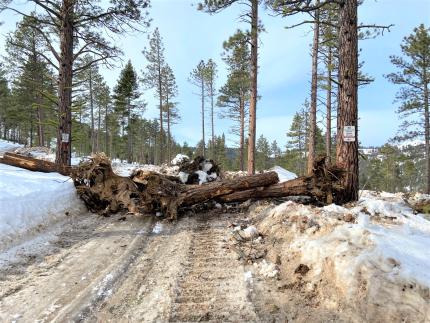
Providing Education and Outreach
Assistant Manager Winegeart attended the Eastern Washington Riparian Symposium in Ellensburg. The training took place over two days and included a day of presentations and a half day of project site visits. Bottom line, your best chance for successful shrub and tree establishment with plants that like to have their roots in water is to plant deep enough that the roots are still in water during the dry season and beaver dam analogues, when properly engineered, can greatly improve riparian habitat, and help water reach higher elevation terraces that are part of the 100-year flood plain.
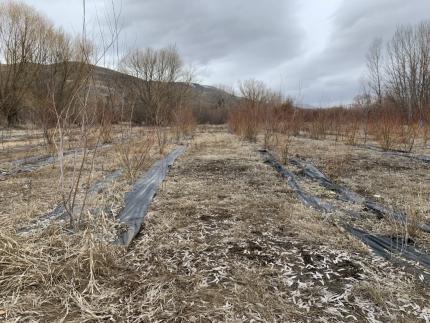
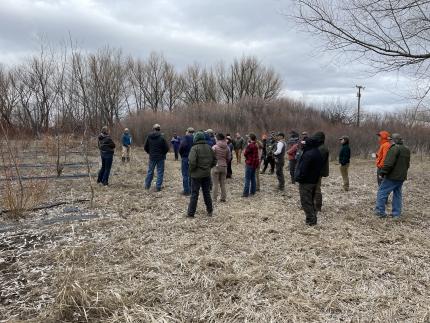
Working with Partners on Fire Prevention Strategies: Private Lands Biologist Hulett took part in Bureau of Land Management’s Lower Basin fire prevention meeting. Hulett shared his knowledge and current projects with the group to help combine efforts for fuel breaks on public and private ownership.
Conducting Business Operations and Policy
Sunnyside Maintenance: Assistant Manager Ferguson and Natural Resource Technician Wascisin have been conducting maintenance on the wildlife area heavy equipment, doing fluid changes, filter changes, and any necessary repairs before the spring planting season.
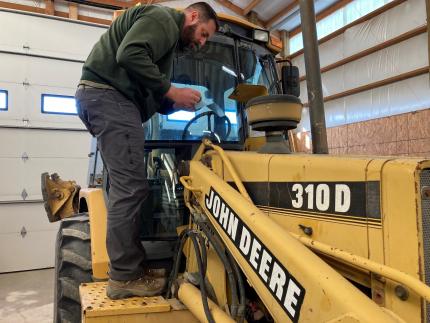
Other
Wenas T-Post Puller Fabrication and Construction: Assistant Manager Taylor, Habitat Specialist Miller, and Recreation Specialist Frame fabricated and assembled seven T-Post pullers for future fence removal projects. The pullers are constructed from square metal tubing and flat bar. Pullers were painted blaze orange for easy visibility. All fabrication and assembly took place in the Wenas shop.
L.T. Murray Hay Damage Issues: Assistant Manager Winegeart fed elk on a few occasions and took note of water damage on some grass and triticale mixed hay. This isn’t the first time the issue of professionally installed hay tarps having holes has surfaced. Hopefully the Joe Watt barn will get a hay shed soon and this will be a problem of the past.
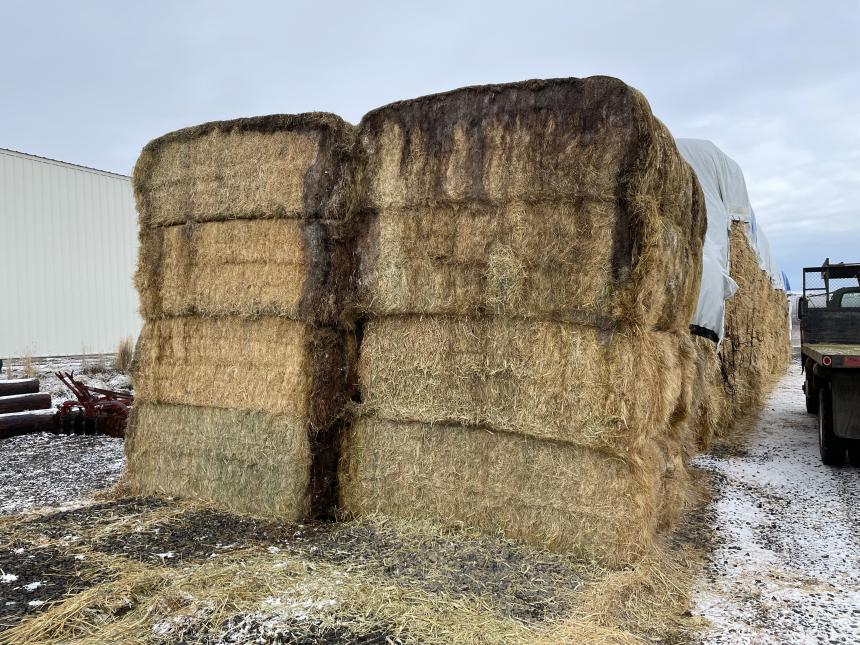
Managing Wildlife Populations
Western Washington Grouse Wing Bee: Biologist Wickhem, Biologist Holman, and Conflict Specialist Aubrey joined biologists from across western Washington and Small Game Specialist Garrison at the annual wing bee. Throughout hunting season, hunters are asked to remove the wings and tails from their harvested grouse and deposit them in collection barrels that are strategically placed throughout the state. Personnel collect these wings and tails from the barrels throughout the season. At the wing bee, staff members bring all their collected wings and tails, and the group goes through each sample to determine the species of grouse, sex, and age, and record the date and location of harvest. This data helps WDFW staff members better understand forest grouse populations across the state and allows managers to make informed decisions about future grouse hunting seasons. At this wing bee, biologists from every western district participated (staff from eastern Washington processed all their wings a few days earlier) and they tallied wings from both ruffed and sooty grouse. For more information on grouse wing collection, visit our website. Thanks to all the hunters that submitted wings during the 2022-2023 season.
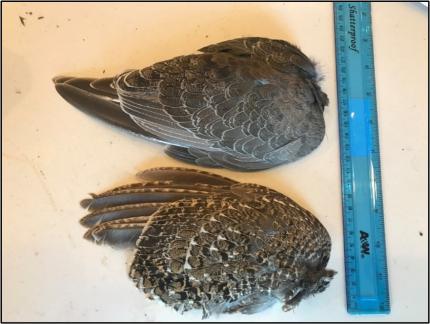
Dusky Canada Goose Surveys: Biologist Wickhem continued the District 9 bi-monthly dusky Canada goose surveys on the Shillapoo Wildlife Area and surrounding lowlands. Dusky geese are a sub-species of Canada goose that spend summers in Alaska and migrate through and overwinter on the lower Columbia River. Dusky geese are closed to recreational harvest due to low population levels. The purpose of the surveys is to count dusky geese observed and read alphanumeric codes on any red-collared duskys. Wildlife managers survey the geese multiple times across their primary wintering grounds and use the data to generate survival estimates. On this survey, Wickhem observed 162 dusky geese and read five goose collars. Other notable sightings included swans, red-tailed hawks, northern harriers, bald eagles, great blue herons, egrets, sandhill cranes, thousands of snow geese, and many species of waterfowl. A big thanks to Assistant Wildlife Area Manager Breitenstein and Photographer Angelo who located and read nine other dusky goose collars last week and reported them to Biologist Wickhem. Every collar counts.
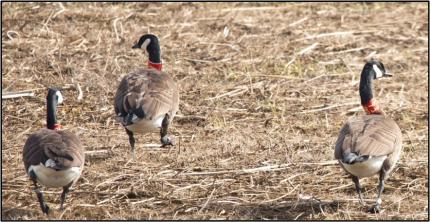
Klickitat Mule Deer Captures: Wildlife Conflict Specialist Jacobsen and Assistant Wildlife Area Manager Hunt captured and collared an adult mule deer doe via tranquilizer darting on the Klickitat Wildlife Area. After three years of capturing and collaring efforts, this was the last deer collared as part of a federally funded study on mule deer migration corridors in central and eastern Klickitat County. These GPS satellite collars will continue to collect data into next winter.
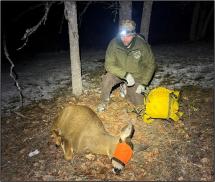
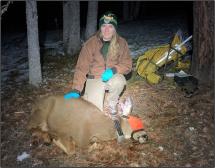
Deer Mortality: Wildlife Conflict Specialist Jacobsen and Volunteer Lieberg completed a mortality investigation on a GPS satellite-collared mule deer. The deer had been dead less than 36 hours, but the carcass had been thoroughly picked over. Based on the findings of the investigation, the mortality was attributed to coyote predation.
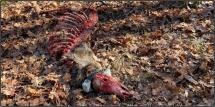
Providing Conflict Prevention and Education
Elk Damage to Hay: Wildlife Conflict Specialist Jacobsen was contacted by a landowner who was frustrated by elk damage to his new hay seeding in Klickitat County. The hay field is in ideal elk habitat, with forestland surrounding all four sides of the 100-acre hay field. Jacobsen discussed different hazing techniques with the landowner and issued permits for lethal removal. The landowner will be working with the Wounded Warrior Project to deploy public hunters on the property.
Another landowner in Clark County with elk damage to hay crops let his son fill his landowner permit to help mitigate elk damage. This was the youth hunter’s first elk harvest.
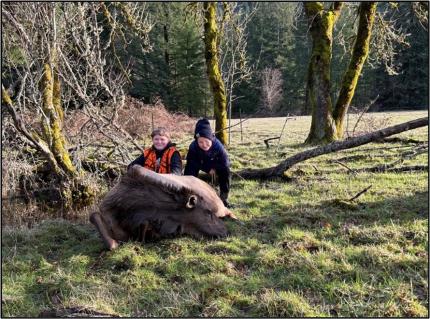
Elk Damage to Fences: A frustrated landowner contacted Wildlife Conflict Specialist Jacobsen regarding elk damage to his fences in Klickitat County. Jacobsen provided advice and schematics for elk crossings to the landowner. Jacobsen informed the landowner that he was not eligible for the lethal removal permits that the landowner was requesting.
Deer Damage to Hay: An agricultural producer in suburban Clark County contacted Wildlife Conflict Specialist Jacobsen to report deer damage to his hay crop. His new hay was starting to sprout, and the landowner had been regularly documenting over a dozen deer visiting the hay crop daily. Jacobsen enrolled the producer in a Damage Prevention Cooperative Agreement and Wildlife Conflict Technician Kolenberg provided the producer with cracker shells to help haze the deer from the property. More aggressive hazing techniques will likely be needed in the future.
Klickitat County Livestock Carcass Sanitation Pilot Program: Wildlife Conflict Specialist Jacobsen recently launched a program in western Klickitat County to assist livestock producers with carcass disposal efforts. The goal of this program is to remove livestock carcasses from the landscape near active livestock operations to help reduce scavenging, habituation, and livestock contact rate from wolves. Jacobsen and Wildlife Conflict Technician Kolenberg collected carcasses from multiple operations and disposed of the carcasses at the regional landfill.
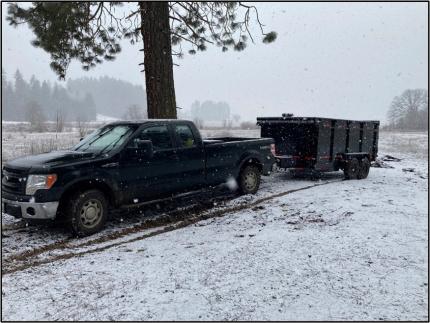
Wolf Activity Updates: Wildlife Conflict Specialist Jacobsen spoke with several different producers in Klickitat County to provide them with updates on wolf activity in the area.
Wolf Concerns: A Klickitat County resident contacted Wildlife Conflict Specialist Jacobsen regarding wolf tracks near his house. Based on wolf GPS collar data, it was likely that the tracks did belong to a wolf. Jacobsen provided advice to the landowner on keeping his dogs secured near the residence.
Cougar Concerns: Wildlife Conflict Specialist Jacobsen was contacted by a landowner in Klickitat County who was concerned that a cougar may have killed a deer near his livestock. The landowner has two yearling steers weighing 400 to 600 pounds. After examining photos of the carcass, Jacobsen was able to determine that coyotes were the likely cause of death for the deer. Jacobsen shared with the landowner that the steers were large enough that there was no risk from either coyote or cougar depredation.
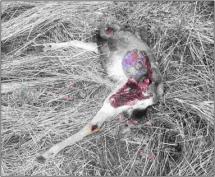
Conserving Natural Landscapes
Klickitat Wildlife Area Volunteer Project: Wildlife Area Assistant Manager Hunt led two master hunter volunteers cutting over-hanging tree limbs along the North Breaks Road, Anderson Road (including behind the gate), Old Headquarters Road (including behind the gate), and Sheep Canyon Road. The volunteers used pole saws and loppers to remove all limbs that were under ten feet high to protect the Capital Asset Management Program road crew’s equipment during road grading work. The volunteers were able to complete all the roads Hunt had in mind largely because both volunteers were hard workers and stayed on task throughout the day. Both volunteers said that they had a great time and look forward to coming out to the Klickitat Wildlife Area again to volunteer. We will have more work for them to do next Saturday.
Conducting Business Operations and Policy
Improvements to WDFW 413: Biologist Holman completed improvements to WDFW Vessel 413. The “Dusky” is a 19 foot, 1980 Alumaweld hard-top primarily used for wildlife work on the Lower Columbia River. Projects spanning waterfowl, shorebirds, Columbian white-tailed deer, marine mammals, and band-tailed pigeons have been aided by the size, range, seaworthiness, and reliability of the Dusky over her now over 40 years of service to WDFW’s mission. This year’s improvements included standard service to the 150 horsepower primary motor and the addition of a new 20 horsepower auxiliary motor, hydraulic steering system, and folding bow ladder for easer island hopping. Collectively the upgrades will make the boat safer and more efficient for its wildlife management work.
